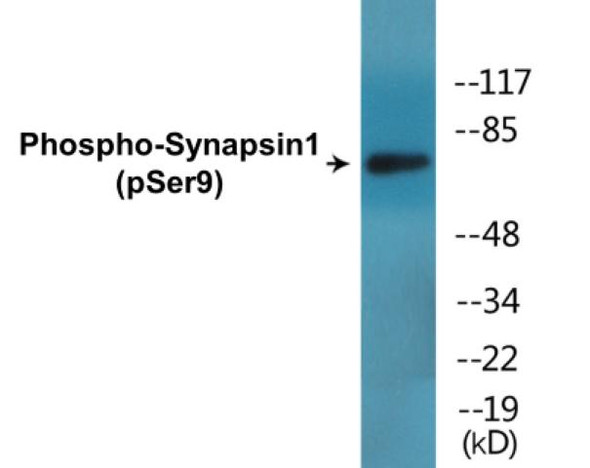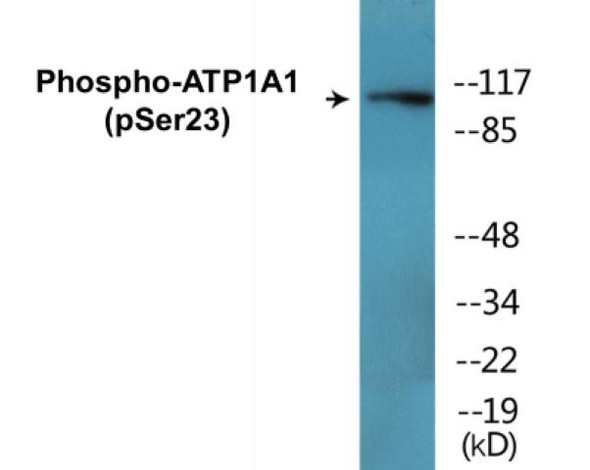Synapsin1 (Phospho-Ser62) Colorimetric Cell-Based ELISA Kit
- SKU:
- CBCAB01323
- Product Type:
- ELISA Kit
- ELISA Type:
- Cell Based Phospho Specific
- Reactivity:
- Human
- Mouse
- Rat
- Detection Method:
- Colorimetric
Description
Synapsin1 (Phospho-Ser62)Colorimetric Cell-Based ELISA Kit
The Synapsin1 (Phospho-Ser62) Colorimetric Cell Based ELISA kit is specifically designed for the accurate detection of phosphorylated Ser62 levels of Synapsin1 in cell lysates and tissue lysates. This kit is highly sensitive and specific, providing reliable and reproducible results for a wide range of research applications.Synapsin1 is a key protein involved in synaptic vesicle trafficking and neurotransmitter release, playing a crucial role in synaptic plasticity and neuronal communication. Phosphorylation of Ser62 on Synapsin1 has been linked to synaptic activity and regulation, making it an important biomarker for studying synaptic function in various neurological conditions, including Alzheimer's disease, Parkinson's disease, and schizophrenia.
This ELISA kit provides researchers with a valuable tool for studying the role of phosphorylated Synapsin1 in synaptic transmission, plasticity, and neurological disorders. Its high sensitivity and specificity make it a reliable choice for accurate measurement of phosphorylated Ser62 levels, helping to advance our understanding of synaptic function and potential therapeutic targets in neurodegenerative diseases.
| Product Name: | Synapsin1 (Phospho-Ser62) Colorimetric Cell-Based ELISA |
| Product Code: | CBCAB01323 |
| ELISA Type: | Cell-Based |
| Target: | Synapsin1 (Phospho-Ser62) |
| Reactivity: | Human, Mouse, Rat |
| Dynamic Range: | > 5000 Cells |
| Detection Method: | Colorimetric 450 nm |
| Format: | 2 x 96-Well Microplates |
The Synapsin1 (Phospho-Ser62) Colorimetric Cell-Based ELISA Kit is a convenient, lysate-free, high throughput and sensitive assay kit that can detect Synapsin1 protein phosphorylation and expression profile in cells. The kit can be used for measuring the relative amounts of phosphorylated Synapsin1 in cultured cells as well as screening for the effects that various treatments, inhibitors (ie. siRNA or chemicals), or activators have on Synapsin1 phosphorylation.
Qualitative determination of Synapsin1 (Phospho-Ser62) concentration is achieved by an indirect ELISA format. In essence, Synapsin1 (Phospho-Ser62) is captured by Synapsin1 (Phospho-Ser62)-specific primary (1ø) antibodies while the HRP-conjugated secondary (2ø) antibodies bind the Fc region of the 1ø antibody. Through this binding, the HRP enzyme conjugated to the 2ø antibody can catalyze a colorimetric reaction upon substrate addition. Due to the qualitative nature of the Cell-Based ELISA, multiple normalization methods are needed:
| 1. | A monoclonal antibody specific for human GAPDH is included to serve as an internal positive control in normalizing the target absorbance values. |
| 2. | Following the colorimetric measurement of HRP activity via substrate addition, the Crystal Violet whole-cell staining method may be used to determine cell density. After staining, the results can be analysed by normalizing the absorbance values to cell amounts, by which the plating difference can be adjusted. |
| Database Information: | Gene ID: 6853, UniProt ID: P17600, OMIM: 300491/313440, Unigene: Hs.225936 |
| Gene Symbol: | SYN1 |
| Sub Type: | Phospho |
| UniProt Protein Function: | SYN1: neuronal phosphoprotein which associates with the cytoplasmic surface of synaptic vesicles and binds to the cytoskeleton. May function in the regulation of neurotransmitter release and of axonogenesis and synaptogenesis. Mutations may be associated with X-linked disorders with primary neuronal degeneration such as Rett syndrome. Two differentially spiced isoforms have been reported. |
| UniProt Protein Details: | Protein type:Vesicle Chromosomal Location of Human Ortholog: Xp11.23 Cellular Component: synaptic vesicle Molecular Function:ATP binding; protein binding; protein kinase binding; transporter activity Biological Process: regulation of neurotransmitter secretion; synaptic transmission Disease: Epilepsy, X-linked, With Variable Learning Disabilities And Behavior Disorders |
| NCBI Summary: | This gene is a member of the synapsin gene family. Synapsins encode neuronal phosphoproteins which associate with the cytoplasmic surface of synaptic vesicles. Family members are characterized by common protein domains, and they are implicated in synaptogenesis and the modulation of neurotransmitter release, suggesting a potential role in several neuropsychiatric diseases. This member of the synapsin family plays a role in regulation of axonogenesis and synaptogenesis. The protein encoded serves as a substrate for several different protein kinases and phosphorylation may function in the regulation of this protein in the nerve terminal. Mutations in this gene may be associated with X-linked disorders with primary neuronal degeneration such as Rett syndrome. Alternatively spliced transcript variants encoding different isoforms have been identified. [provided by RefSeq, Jul 2008] |
| UniProt Code: | P17600 |
| NCBI GenInfo Identifier: | 73920800 |
| NCBI Gene ID: | 6853 |
| NCBI Accession: | P17600.3 |
| UniProt Secondary Accession: | P17600,O75825, Q5H9A9, B1AJQ1, |
| UniProt Related Accession: | P17600 |
| Molecular Weight: | 70,033 Da |
| NCBI Full Name: | Synapsin-1 |
| NCBI Synonym Full Names: | synapsin I |
| NCBI Official Symbol: | SYN1 |
| NCBI Official Synonym Symbols: | SYNI; SYN1a; SYN1b |
| NCBI Protein Information: | synapsin-1 |
| UniProt Protein Name: | Synapsin-1 |
| UniProt Synonym Protein Names: | Brain protein 4.1; Synapsin I |
| Protein Family: | Synapsin |
| UniProt Gene Name: | SYN1 |
| UniProt Entry Name: | SYN1_HUMAN |
| Component | Quantity |
| 96-Well Cell Culture Clear-Bottom Microplate | 2 plates |
| 10X TBS | 24 mL |
| Quenching Buffer | 24 mL |
| Blocking Buffer | 50 mL |
| 15X Wash Buffer | 50 mL |
| Primary Antibody Diluent | 12 mL |
| 100x Anti-Phospho Target Antibody | 60 µL |
| 100x Anti-Target Antibody | 60 µL |
| Anti-GAPDH Antibody | 60 µL |
| HRP-Conjugated Anti-Rabbit IgG Antibody | 12 mL |
| HRP-Conjugated Anti-Mouse IgG Antibody | 12 mL |
| SDS Solution | 12 mL |
| Stop Solution | 24 mL |
| Ready-to-Use Substrate | 12 mL |
| Crystal Violet Solution | 12 mL |
| Adhesive Plate Seals | 2 seals |
The following materials and/or equipment are NOT provided in this kit but are necessary to successfully conduct the experiment:
- Microplate reader able to measure absorbance at 450 nm and/or 595 nm for Crystal Violet Cell Staining (Optional)
- Micropipettes with capability of measuring volumes ranging from 1 µL to 1 ml
- 37% formaldehyde (Sigma Cat# F-8775) or formaldehyde from other sources
- Squirt bottle, manifold dispenser, multichannel pipette reservoir or automated microplate washer
- Graph paper or computer software capable of generating or displaying logarithmic functions
- Absorbent papers or vacuum aspirator
- Test tubes or microfuge tubes capable of storing ≥1 ml
- Poly-L-Lysine (Sigma Cat# P4832 for suspension cells)
- Orbital shaker (optional)
- Deionized or sterile water
*Note: Protocols are specific to each batch/lot. For the correct instructions please follow the protocol included in your kit.
| Step | Procedure |
| 1. | Seed 200 µL of 20,000 adherent cells in culture medium in each well of a 96-well plate. The plates included in the kit are sterile and treated for cell culture. For suspension cells and loosely attached cells, coat the plates with 100 µL of 10 µg/ml Poly-L-Lysine (not included) to each well of a 96-well plate for 30 minutes at 37 °C prior to adding cells. |
| 2. | Incubate the cells for overnight at 37 °C, 5% CO2. |
| 3. | Treat the cells as desired. |
| 4. | Remove the cell culture medium and rinse with 200 µL of 1x TBS, twice. |
| 5. | Fix the cells by incubating with 100 µL of Fixing Solution for 20 minutes at room temperature. The 4% formaldehyde is used for adherent cells and 8% formaldehyde is used for suspension cells and loosely attached cells. |
| 6. | Remove the Fixing Solution and wash the plate 3 times with 200 µL 1x Wash Buffer for five minutes each time with gentle shaking on the orbital shaker. The plate can be stored at 4 °C for a week. |
| 7. | Add 100 µL of Quenching Buffer and incubate for 20 minutes at room temperature. |
| 8. | Wash the plate 3 times with 1x Wash Buffer for 5 minutes each time. |
| 9. | Add 200 µL of Blocking Buffer and incubate for 1 hour at room temperature. |
| 10. | Wash 3 times with 200 µL of 1x Wash Buffer for 5 minutes each time. |
| 11. | Add 50 µL of 1x primary antibodies Anti-Synapsin1 (Phospho-Ser62) Antibody, Anti-Synapsin1 Antibody and/or Anti-GAPDH Antibody) to the corresponding wells, cover with Parafilm and incubate for 16 hours (overnight) at 4 °C. If the target expression is known to be high, incubate for 2 hours at room temperature. |
| 12. | Wash 3 times with 200 µL of 1x Wash Buffer for 5 minutes each time. |
| 13. | Add 50 µL of 1x secondary antibodies (HRP-Conjugated AntiRabbit IgG Antibody or HRP-Conjugated Anti-Mouse IgG Antibody) to corresponding wells and incubate for 1.5 hours at room temperature. |
| 14. | Wash 3 times with 200 µL of 1x Wash Buffer for 5 minutes each time. |
| 15. | Add 50 µL of Ready-to-Use Substrate to each well and incubate for 30 minutes at room temperature in the dark. |
| 16. | Add 50 µL of Stop Solution to each well and read OD at 450 nm immediately using the microplate reader. |
(Additional Crystal Violet staining may be performed if desired – details of this may be found in the kit technical manual.)










